Xiphophorus
This genus exists of swordtails and platies (also called platy fish). The name "Xiphophorus " is a composition of two Greek words, meaning "dagger" and "bearer". Looking at swordtails, you'd expect it to be referred to the sword shaped tail but it actually refers to the gonopodium.
Note: Not all swordtail males do develop a sword and with some platy strains males can develop a very short swordtail. With this being said, the sword (elongated lower fin rays of the caudal) seems to be a sexual preferable trait to female swordtails and female platy fish. It's known that swordtails and platy fish are able to interbreed with another. It's also known that female livebearers decide wether a certain male is allowed to mate with her (no matter how often a random male may chases her and even tries to aim his gonopodium in her direction). But if a male swordtail or a male platy with a sword is present, she'll most likely prefer such a male to be her mating partner instead of a male with no sword. Which makes it also more likely that a female platy will choose to mate with a swordtail than with another platy when both species are kept together in one tank. So, in reference to mating selection in general, females of Xiphophorus species prefer swords of male swordtails and platy fish more than the coloration on the male's body.



Above and left: The tip of a gonopodium of a male swordtail (with the exception of Xiphophorus signum that differs from other wild swordtails).
Left: Photomicrograph of the distal part of a gonopodium
of X. hellerii from the assessment area.
Swordtails inhabit waters ranging from Belize, Honduras, Panama (not sure if they were introduced by man), Guatemala and mainly Mexico. Platies however occur only in Mexico. Swordtails do occur in freshwater but also in brackish waters. They can even get used to marine water just like mollies. But just like guppies, swordtails and platyfish were also introduced by man to other waters all over the world. For a lot of swordtail strains do occur in higher situated areas where it can be a lot colder which makes them excellent inhabitants in other colder areas. This tells us as well that we should label swordtails as being subtropical instead of tropical.
There are so many different swordtail and platy strains in the wild. The fancy swordtail strains we know are all derived from the Xiphophorus hellerii and the fancy platy strains from the Xiphophorus maculatus and the Xiphophorus variatus. But again, besides these three... there are way more wild strains of swordtails and platies.
Swordtails in the wild are divided into 2 groups: the southern and the northern swordtails. The northern swordtails are smaller in size and occur more in Belize, Honduras and Quatemala. The southern swordtails however do occur mainly in Mexico (for Xiphophorus signum and Xiphophorus mayae ain't endemic to Mexico) and are larger in size.
In general, the lateral line(s) on both sides of the body is darker with northern swordtails and lighter colored with southern swordtails.
The southern swordtails can be divided into 2 subgroups: the Hellerii group and the Clemenciae group. To the Helleri group belongs X.hellerii, X. mayae, X.signum and X. alvarezi. To the Clemenciae group belongs X.clemenciae, X.monticolus and X.mixei. Last 2 mentioned are very hard to find within the aquarium scene. In free nature depending on the location where the swordtails can be found, multiple phenotypes will show up within each wild swordtail species. This has got to do with hierarchy and external factors like e.g., the available food sources, etc... And it seems that within the Hellerii group multiple phenotypes are more at hand than within the Clemenciae group and the northern swordtail species. Some remarks can be made regarding the genetic history of the X.clemenciae and the X.monticolus. Both swordtail species seem to be evolved through a natural hybridization between swordtail and platy. Just the exact swordtail and platy ancestors are not clear identified. But both X.clemenciae and X.monticolus as current species are officially recognized as being swordtail species.
A quote from an article about the X.monticolus:
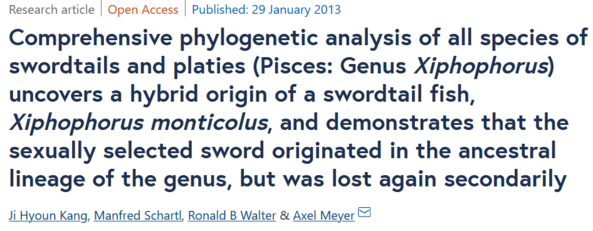
Below: A good example of a wild swordtail species that has lost the sword trait secondarily is the Xiphophorus Birchmanni.

Above: Two male Xiphophorus Birchmanni (also known as sheepshead swordtail).
The sword of a male swordtail or male platy fish is an ancestral ornament. It's nothing more than a number of elongated lower fin rays of the caudal itself. The sword is developed by upregulating (stimulation of the activity of certain receptors located on cells by hormones) the MSX genes (methionine sulfoximine, this is an irreversible enzyme {glutamine synthetase inhibitor} which is responsible for morphogenesis of tissues).

Below: The first stages of developing a sword (elongated lower outer fin rays of the caudal fin) in male swordtails that will develop an actual sword (mind that there are wild swordtail species that won't develop a sword).




All swordtail and platy fish species found in other areas on this globe are introduced by man and are therefore feral strains.
Overhere a summary of all wild caught swordtails and wild caught platy fish (which were used for research) and their GPS locations as far as known of course:

Overhere a phylogenetic tree of all known wild Xiphophorus species:



Wild swordtail fish have been introduced succesfully in other countries as well, like in Morocco, Iran and Australia. But after the populations increased, they became invasive, out-competing and endangering native species.
Breeding forms of swordtail fish have been introduced at the Canary islands, like Tenerife. And those breeding forms can even be found in marine water. Swordtails are to be found in freshwater and brackish waters. But they can adjust to salt water.
The most common varieties of swordtail fish which are available through retail are Hellerii swordtail fish (Xiphophorus hellerii). The official scientific name of the hellerii swordtail is "Xiphophorus hellerii" but the second name "hellerii" is also spelled as "Helleri". But the two "i's" is the official one. In wild nature the Xiphophorus hellerii is the most naturally wide spread wild swordtail species. At the different locations where these helleriis are found, the wild phenotypes differ a lot in coloration and pattern. Eventhough, this is a fact, but each hellerii population found in free nature is one and the same species. They're all color morphs of the same kind of swordtail species. Environmental factors are in play why a different phenotype occurs at a different location.
The Xiphophorus hellerii is also known as the green swordtail fish. But actually, calling the Xiphophorus hellerii the green swordtail doesn't really give a proper image of the Xiphophorus hellerii. Simply because of the fact that not all wild helleriis are having the same body color. And there are other wild swordtail species that aren't helleriis that suit the name "green swordtail fish" as well.
Note: Males of the Xiphophorus species may develop a so-called "pseudo gravid spot". This phenomenon happens mostly with platy species in comparison to swordtail species. Mostly such a pseudo gravid spot will be developed during or after the transition of the anal fin into a gonopodium. It hardly happens before the anal fin's transition. This has got nothing to do with a female turning into a male. For that's a different story.
A gravid spot of a female is the most translucent part of the skin while a pseudo gravid spot is developed in the skin (and absolutely not translucent). But once a pseudo gravid spot is developed, it will never fade nor disappear.

Above: An adult swordtail male.
Note: Once a pseudo gravid spot has shown on a male's body, it will never disappear.
Sex change:
Swordtail species "can" be born with both male and female gonads. Which makes it possible that female specimens can change gender. Even when she's been pregnant before. But in that case, the female will keep her gravid spot. And the transformed specimens will be functional males when it comes to reproduction. But yes, also females can change gender after they've had their definite last batch of fry. There are also old females that will show male characteristics (like elongated outer caudal and anal fin rays). In this case, it will be another story. For a hormonal trigger will make the MSX genes strongly active which will affect the morphological state of the finnage in female swordtails. Such an old female will stop breeding.
In general, such a transition from female to male, will take place after a certain trigger (only possible as long as such a female is an Aa genotype). An example could be an unbalanced male/female ratio within the group or even a lack of hierarchy within the group. But there are more triggers to establish a sex change.
Males however can not change gender for the transition of the anal fin into a gonopodium is irreversible. In the past I've put pregnant females separate. They've dropped fry and some changed into functional males. I've put some together with young virgin (but already sexually mature) and they were impregnated by transformed females. The offspring were fertile.

Above: Quoted from Manfred Schartl.
Note: A sex change does not only happy to Xiphophorus species. It can also happen to a number of other kinds of livebearer species. But not with all kinds. But it happens mostly with Xiphophorus species as best known livebearer family.
Among the 26 species of the genus Xiphophorus (swordtails and platyfish) are species with both XY and ZW sex chromosome systems. In this genus, these simple heterogametic systems are both present together with more complex situations that can include multiple loci and chromosomes.
If there's a lack of males or even no males within a group but there are fry present, you'll notice that there will be fast developing young males. These males stay small in comparison to an average male's body size. This is to ensure the reproduction and the existence of the species. What's also remarkable with early males is that the majority of their offspring will be male at an average temperature. With late males a majority of female offspring will be the result (and again at an average temperature).
WIld swordtails

Above: An adult pair of green swordtails (Xiphophorus hellerii) as described by Heckel in 1848. This swordtail species has been named after its collector Austrain (but born in former Czechoslovakia) botanist Professor Karl Bartholomäus Heller.
Photo courtesy Florida Museum.

Above: Professor Karl Bartholomäus Heller ( ☼ November 20 1824 - .†December 14 1880).
Professor Karl Bartholomäus Heller discovered the swordtail fish while exploring México in 1845–1848. The green swordtail was described from Heller's type by Johan Jakob Heckel in 1848 with the type locality given as Orizaba, Mexico.
Although, the name "green swordtail" is referred to Xiphophorus hellerii, there are also other green swordtail species other than Xiphophorus hellerii. So basically, if we speak about the green swordtail, we must give a specific detail about the actual swordtail species... Hellerii or not...? But the fancy breeds that we commercially find are derived from Xiphophorus hellerii (and not from other wild swordtail species). Most (so, not all...) of them are derived from crosses between Xiphophorus hellerii to Xiphophorus maculatus or Xiphophorus variatus. This makes the majority of fancy swordtails hybrids and no pure swordtail fish. But the commercial world would label them as being Xiphophorus hellerii. Incorrect but this is how the commercial world works.
Xiphophorus pygmaeus
One of the wild forms is the dwarf swordtail (Xiphophorus pygmaeus). These dwarfs are to be found in the Pánuco River system in Northeastern Mexico.
It's a swordtail which really shows its wild nature in comparison to other swordtails. These are in some way shy fish which will hide when they can.
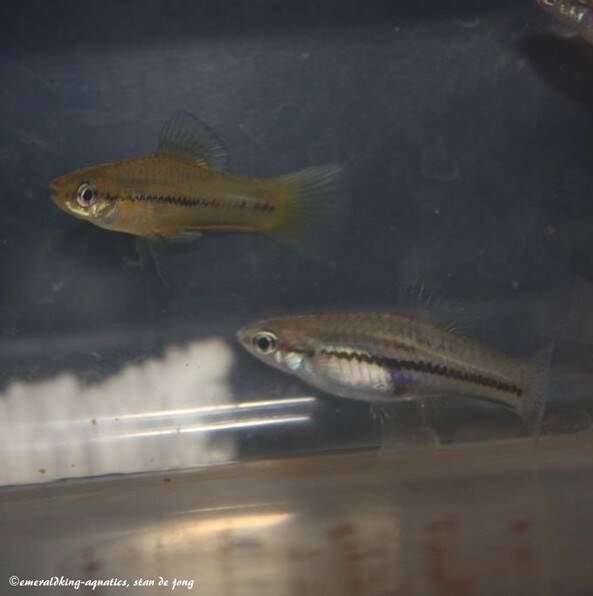

Above: An adult couple (photo left) and an adult male (photo right).

There are two versions: the golden and the blue version. The blue version is not blue but that's how the wild colour is called. But note that both females of the blue and gold version are blue. So, a golden colored female doesn't exist. In captivity they grow up to 4cm.

Xiphophorus continens
Another dwarf swordtail is the Xiphophorus continens and also known as El Quince swordfish.
This dwarf is to be found in Rio Panuco drainage in San Luis Potosi in Mexico where it inhabits an environment with fast flowing water.

Just like the Xiphophorus pygmaeus, the males of this species carries also a very short sword. And some males just won't grow a sword which is also comparable with the Xiphophorus pygmaeus. The same goes for their size.
The stripe on both sides seems clearly different from their dwarf relative.
It's a friendly swordtail which is suitable for smaller tanks but be sure of it that they still have sufficient swimming space for they are very vividly.
Gestation will take up 3,5-4 weeks in general and the amount of fry won't be that large. A good batch will be at 10-15 fry each drop.
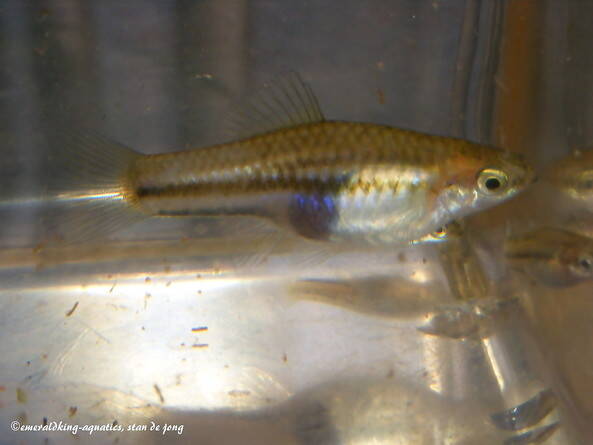
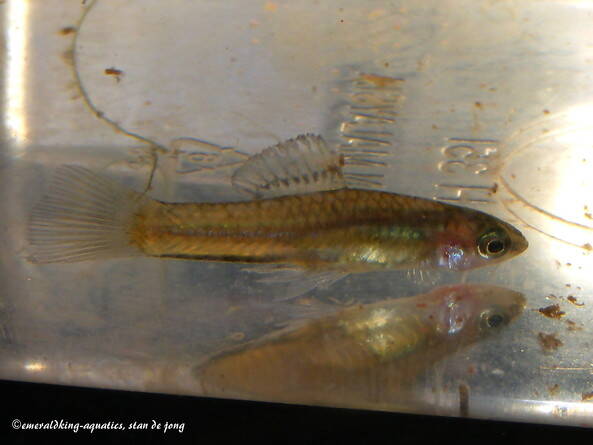
Above: An adult female (photo left) and an adult male (photo right).
The males are quite slender in body build in comparison to a female.

Above: Rio Valles (Gulf of Mexico, Pánuco drainage).
Xiphophorus multilineatus
Also a very interesting and beautiful dwaf swordtail is the Xiphophorus multilineatus. This dwarf is endemic to the Rio Choy of Rio Pánuco basin in San Luis Potosi in Mexico.
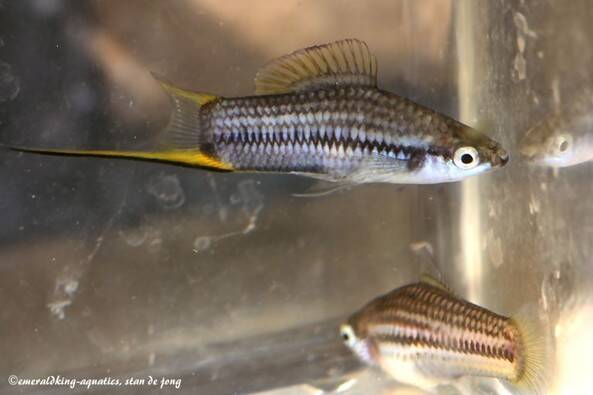
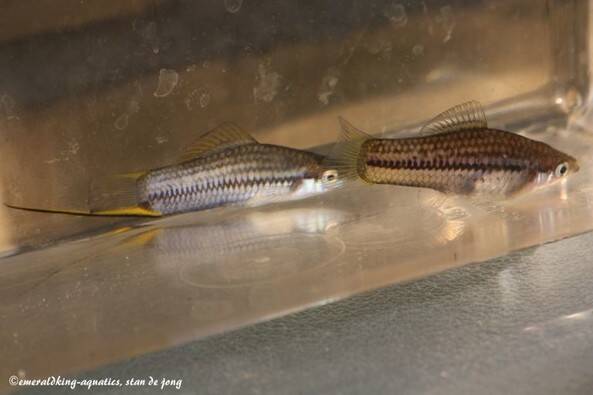
These swordtails will reach up from 4 cm to 5cm of length. That's just body length and the swordtail is not included yet. females tend to grow up a bit more in comparison to the males. If we look at the appearance of the females, they do have similarities to the females of the X.pygmaeus and X.continens.


Above: An adult female (photo left) and a few weeks old fry (photo right).
Best kept at moderate temperatures 22°C-25°C.
In some way there are very different visions on how hard they seem to reproduce. I myself haven't had any problems to get them to breed. To me it seemed that they reproduced easily. The offspring will look like the mother when it comes to their phenotype.
The gestation itself may take 3-4 weeks and an average batch of 5-15 fry will be born.
Once the juvenile males will show their gender, the males will slowly change their colors and bodyshape. The horizontal stripe pattern will dissappear. And a lateral line which is edged shaped will remain on both sides. By the way, also the females will have such a lateral line. But depending on their mood and how the light will refelct their bodies, you'll be able to see more horizontal lines (which are not edged shaped).
The males will develop a yellow-orange coloration in the dorsal and caudal.

They prefer some water flow in the tank. So, be sure to give them that.



Above, top right & bottom right: Rio Choy.


Xiphophorus hellerii
The most known version of the swordtails is the regular green swordtail (Xiphophorus hellerii). The subname "Hellerii" is also spelled like "Helleri". Both spellings are correct. The subname "Hellerii" is derived from the Austrian botanist and naturalist Karl Heller. Heller collected them and brought the first versions of this species to Vienna, Austria after a number of expeditions in Mexico during the period of 1845 - 1848. The species has been described for the first time by Johann Jakob Heckel (Austrian zoologist, ichthyologist and taxidermist) in 1848.

This is the most wide spread swordtail species and occurs in Mexico, Honduras, Guatemala and Belize. But also by translocation, the X.hellerii is the most wide spread wild swordtail on this globe( a range of approximately 1100 km). Despite of the fact that all Xiphophorus helleriis found at different locations in the wild are one and the same species, they do differ in phenotype.
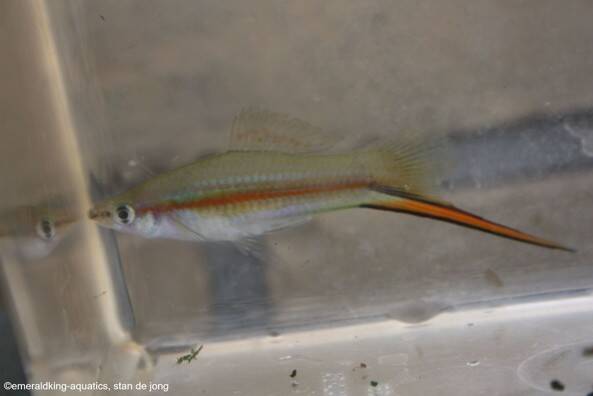
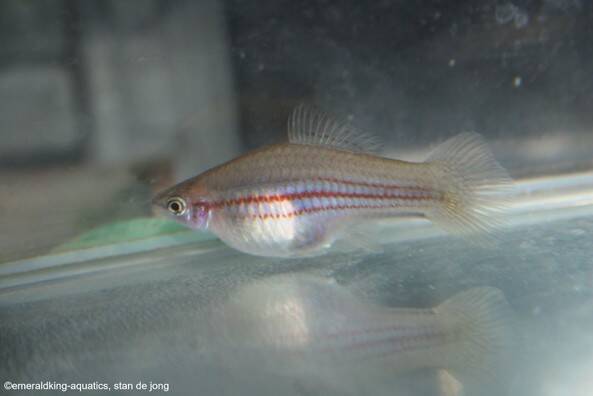
Above: An adult male (photo left) and an adult female (photo right).
So, because of the wide range of distribution of this species, the phenotypes may differ a lot from each single location as I was saying. Not just coloration and pattern but also the size of the several X.hellerii colonies differ. But in general a good adult size (without the sword) is between 7 - 12 cm. Of course, there are also larger and smaller ones (depending on a number of other factors).
They occur in both fast flowing waters and still waters. Also the X.hellerii is a good contender to keep outdoors during the better months of the year. This species does well between a range of 15 - 25°C.
The X.hellerii is also the ancestor of many fancy swordtail strains within the aquarium scene by linebreeding and also by inbreeding with platy fish.
Overhere, a fancy swordtail strain (orange Mickey Mouse swordtail) of Xiphophorus hellerii:

Xiphophorus hellerii Rio Jalapa
This slender swordtail within the Hellerii group was firstly found in clear streams of the Orizaba mountain (highest mountain in Mexico) in Mexico by Karl Heller. This specific swordtail was send to Vienna as described already above (Xiphophorus hellerii). These fish were send dead and were kept in alcohol.
As already been mentioned, this swordtail species originates from clear streams of the the Orizaba mountain (also known as "Pico de Orizaba" and "Citlaltépetl"). This mountain is the highest mountain and also the highest volcano in Mexico and It rises 5,636 metres (18,491 ft) above sea level. This already tells us that these swordtails occur in cold water. In captivity bred specimens should be kept at lower till moderate water temperatures to let them thrive well. It also tells us that we are not dealing with a tropical species but a subtropical species.
The name "Jalapa" is derived from "Xalapa". In the Nahuatl language it's called "Xallapan" which means "Source in the sand".

In 1902 the species were redescribed by Meek under the name of Xiphophorus Jalapa. This is in fact an older synonym for Xiphophorus helllerii. Nowadays, this species is also known as Xiphophorus hellerii Rio jalapa.
Ever since 1909 the Xiphophorus hellerii is kept in fishtanks. It's discussable wether these X.hellerii were the same phenotype as the original found X.hellerii Jalapa found in the streams of the Orizaba mountain.
Later on specimens of this stock were collected again in the spring of 1963 from a tributary of the Rio Chachalaca, near the town of Jalapa, Veracruz, Mexico. These fish were maintained as a stock at the Zoological Institute in Hamburg, Germany (Zander, 1967).
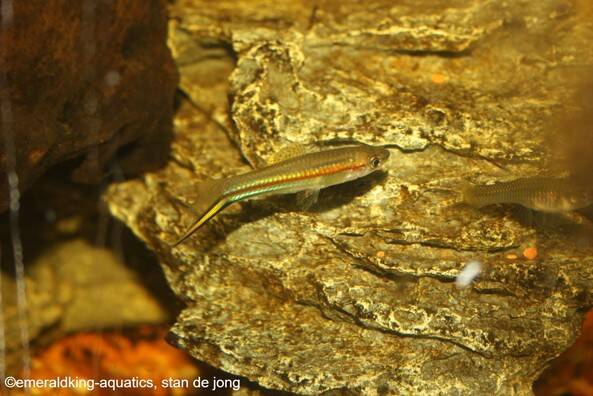
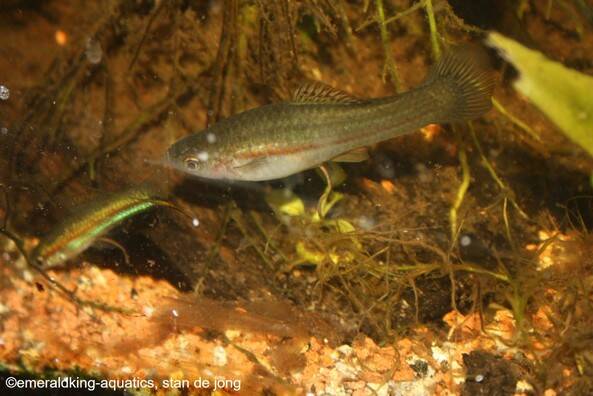
There are phenotypically differences between this X.hellerii species in comparison to the X.hellerii species mentioned before. With the most clear difference of the neon or metallic shine. But despite of that, it's the same swordtail species.



Above: Pico de Orizaba.
Xiphophorus hellerii palenque
The Xiphophorus hellerii palenque is quite similar to the regular Xiphophorus hellerii. And there's really not that much info about them than just knowing their locality of occurrence in Palenque. Palenque is a Maya city in the state of Chiapas, Mexico and is formely known as "Lakamha". This name means "big water" or "big waters" in the ancient language "Itza". The area is 150 meters (490 ft) above sea level.

This is a typical green swordtail. Sometimes some more yellowish specimens do occur within a group. This species won't show any red with the exception of the lateral lines. They're similar in behavior and maintenance as other Helleriis.
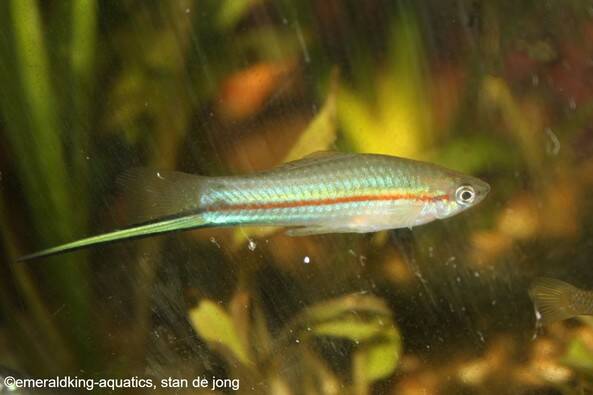
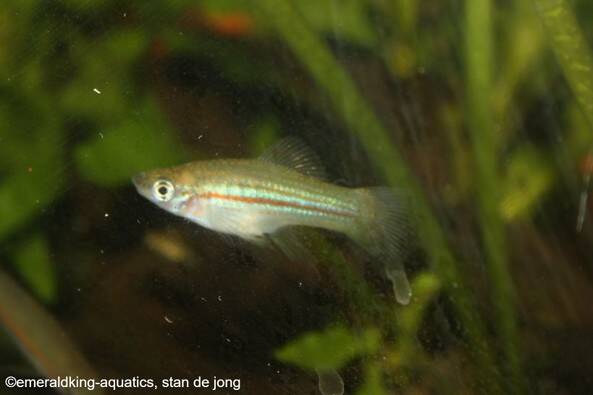
Above: An adult male (photo left) and an adult female (photo right).


Below: Palenque (Maya city state).


Xiphophorus nezahualcoyotl
This Xiphophorus species, they're also known as "Nezzies". The name "Nezahualcoyotl" means "hungry coyote". And this strain was named after an Acolhuan philosopher, ruler and warrior by the name of Acolmiztli Nezahualcoyotl (☼1402 - †1472). But the species itself was described in 1990 while the first specimens of this swordtail species was imported in 1913. This had to do with the fact that this species was thought to be a variety of the Xiphophorus montezumae.

This sport inhabits fast till moderate flowing creeks in mountainous areas (about 1200 meters) and some cenotes which are parts of the Rio Tamesi drainage (state of San Luis Potosi, eastern Mexico). And will do well at water temperatures between 18°C - 22°C. Healthwise, it's better for them to keep them between 18°C - 20°C during the winter season.
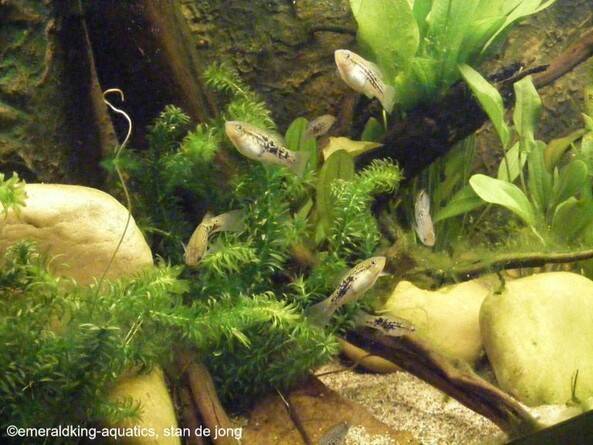
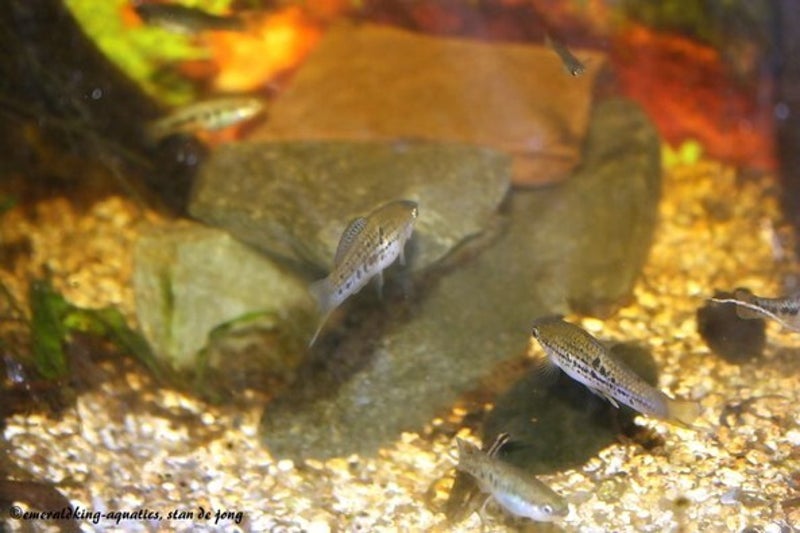

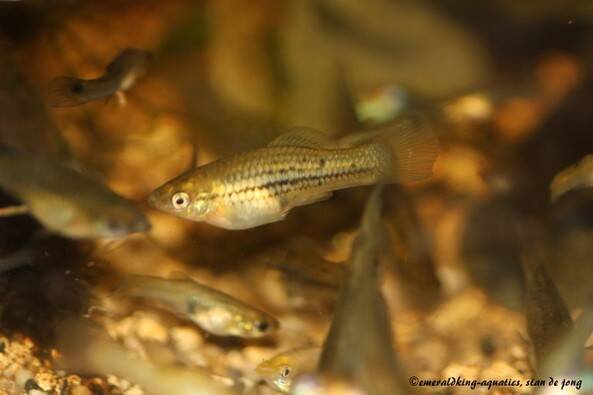
Above: Two adult male (photo left) and an adult female (photo right).

Below: Wetlands and lagoons of the lower Rio Tamesí (Photo by P. H. Hudson).

This swordtail won't become that large and could be considered a dwarf swordtail as well. Average size of an adult male will be about 5 cm (sword not included). And an average size of a female will be 5-6 cm.
Xiphophorus Alvarezi
This swordtail is also called "Chiapas swordtail".
The X.alvarezi occurs in Rio Santo Domingo in the state of Chiapas in Mexico and Huehuetenango, El Quiche and Alta Veracruz in Quatemala.

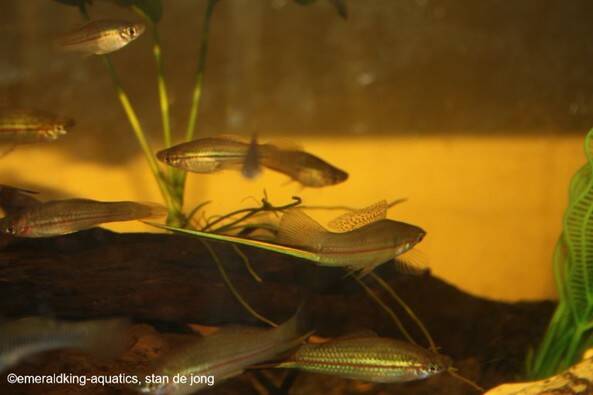
The difference between Alvarezis and Helleriis, is to be found by the number of fin rays and scales in the longitudinal direction. This swordtail species has got 3-4 lateral lines on both sides of the body. And a blue-green shine all over the body when light hits the body. And they've got red points on the dorsal. There are also male specimens that will show some red on the body (these are mostly dominant males).




Below: Rio Santo Domingo.


Xiphophorus helleri yucatan
Another great wild strain of swordtail is the Xiphophorus hellerii yucatan. It's a swordtail which can grow up explicit larger than the average swordtail.

This strain is from the Yucatán peninsula (Mexico). It concerns also a green swordtail (don't take "green" too literally) and as already been mentioned they do grow up large. There's one specific stripe on both sides of the body which shows very clear. This stripe is wine red colored. But with dominant males you'll hardly see this stripe on each side. This is because dominant males tend to get a red or orange color which covers the whole lower part of the body which will cover the wine red stripe. But sometimes a green male can become almost totally red instead of partially. But the number of males that will turn almost red is pretty low.

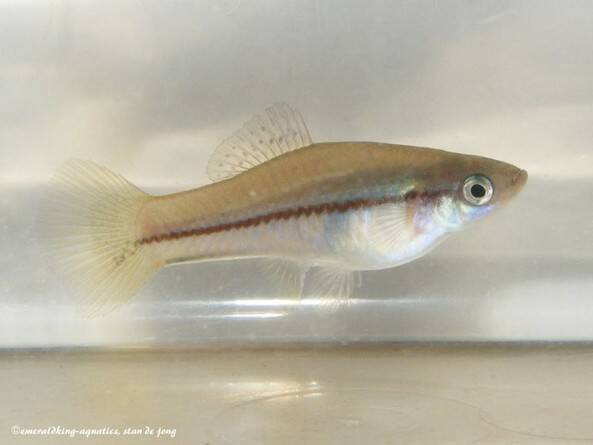
Above: An adult dominant male (photo left) and an adult female (photo right).
Below: A group of Yucatan swordtails. In this picture are 2 red males to be seen. The upper one still shows some green under the red coloration on the upper part of the body. The lower red male is already totally covered with the red coloration and no green to be seen anymore. It's really remarkable that a green swordtail turns into a red swordtail.
These swordtails are highly prolific and even those fry already show a ferm body build. About eating their own fry is something I hear several stories about. But I honestly do have to mention that my experience with these fish is that fry won't be eaten. I just leave those fry in the open with those adults.

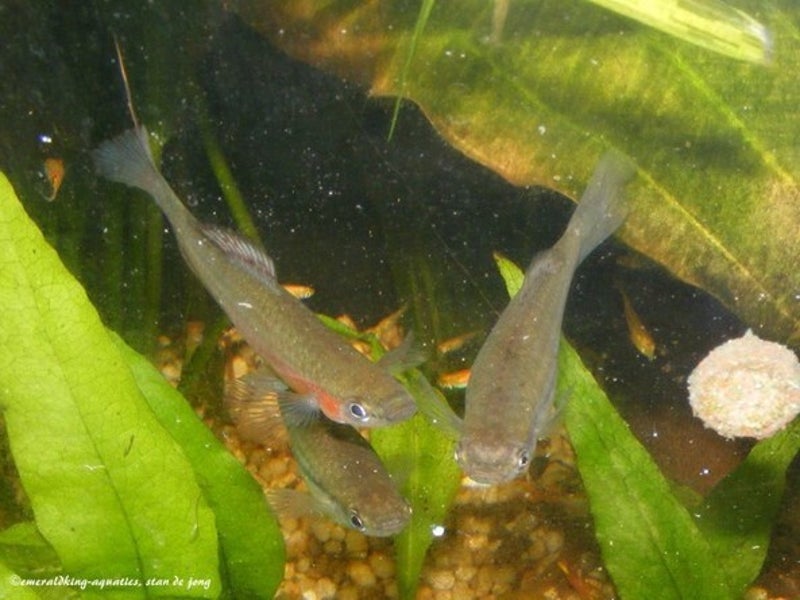
They do well at lower temperatures and for sure suitable to keep outdoors when the temperatures will allow it. I'd like to categorize this strain as being easy to keep.
Note: There's a discussion going on for a long time that this swordtail species is an introduced species. But that has officially never been verified.

Below: One of the cenotes of the Yucatan peninsula. The Yucatan Peninsula is home to an estimated 7000 cenotes.



Above: One side of the Yucatan Peninsula.
Xiphophorus montezumae
The Xiphophorus montezumae ia also known as Montezuma swordtail.
The distribution of the habitats of this strain ranges from Rio Tamesi, Tamaulipas, Northern Veracruz and San Luis Potosi in Mexico.

Depending on the location, the specimens tend to look differently. Most well known version is the one with the typical black markings on their bodies. Both genders "can" have those spots but it seems that males tend to have more black markings in general in comparison to the females. Just a small number has some tiny black markings but most females don't have them. But the amount of black markings also differ from where the original versions came from (so the locality where the originals were caught).
The picture below shows a male which hardly shows black markings (just some tiny spots).

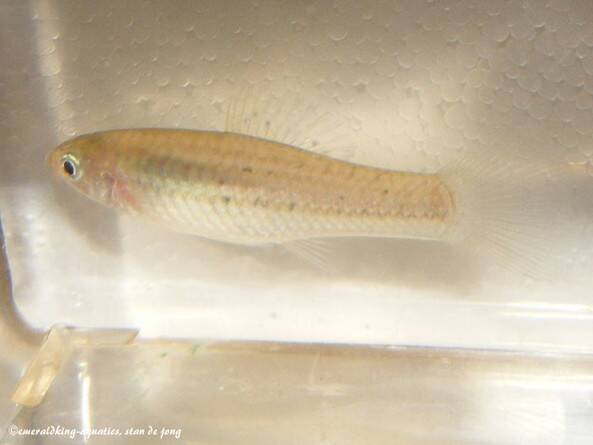
Something which is also very typical with Montezuma swordtails is that you definitely know if you have a female or male when they're almost hitting adulthood. Late males do occur very often with this kind of swordtails as well. Also a clear gravid spot is not present with each female.
It's a very vivid type of swordtail. Which means that they also need sufficient space to swim. Especially when males try to compete with another to see which might be the most dominant male, you need to give them the space they need.
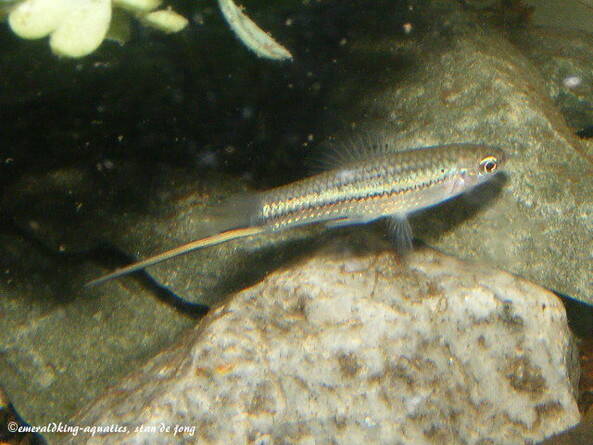
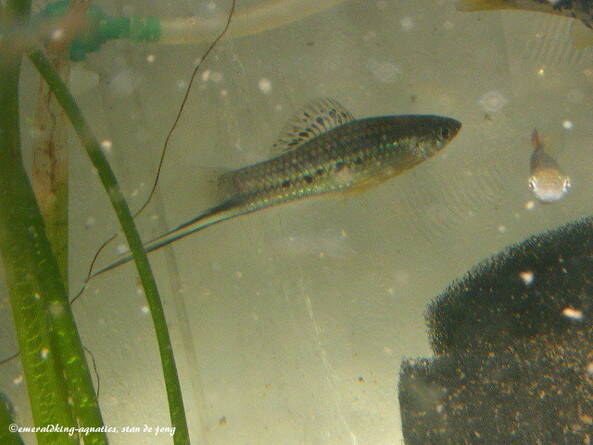
Above: two adult males.
And it's not just because of their vividness that these swordtails need a large tank but it's also because of the sword which a male will develop. For this kind of swordtail will develop one of the largest swords of most known swordtails.

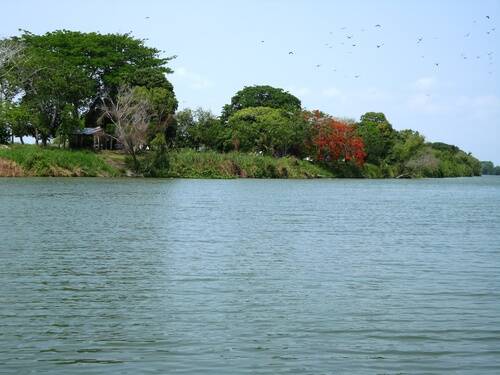
Right: Puente De Dios (Tamasopo)
Below: Laguna del Castillo, Veracruz..


Above: Santa Maria's Canyon close to the Tamul waterfalls in San Luis Potosi.
Left: Rio Tamesi.

Left: Laguna del Castillo (also written as La Laguna de El Castillo) in Veracruz.
Xiphophorus hellerii Rio Papaloapan
Another green wild form of swordtail is the Xiphophorus hellerii Rio Papaloapan. This speckled type of green swordtail occurs in the Rio papaloapan stream in (state of Veracruz) Mexico. The name "Papaloapan" is Nahualtl for "River of the butterflies".

This is one of the most way easiest wild strains there is. Thusfar, is seems that they do well in a wide range of waterparameters. Even when it comes to reproduction they seem one of the most prolific ones. It also seems that they have a shorter gestation than other wild swordtails. My own experience shows an average gestation of 3 weeks. And the fry also grows up faster than most. I do keep them at low temperatures and even with those rates they reproduce fast.
Most fry show speckles already at an early stage. But the amount of body speckles do differ from fish to fish.
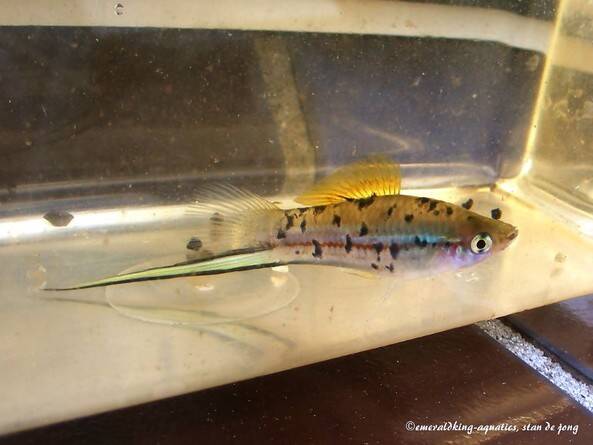
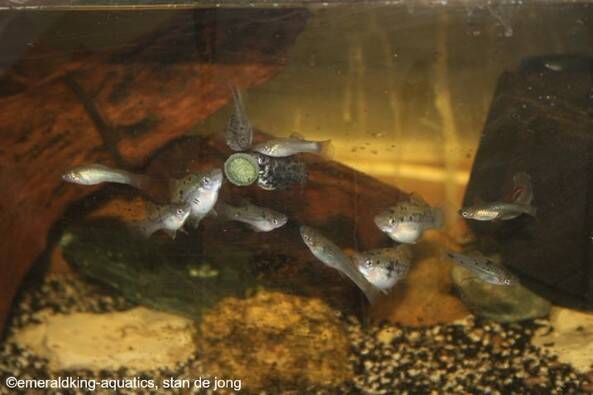
This is an average sized swordtail which has a lack of dominant behavior in a tank unlike a lot of other swordtail strains. Which makes this kind a good contender for a community tank.


Below: Rio Papaloapan in the state of Veracruz.


Xiphophorus signum
The comma swordtail (Xiphophorus signum) is endemic to Rio Chajmaic (part of the Rio Usumacinta basin) and the tributaries and in particular the Rio Semococh in the state of Alta Verapaz in Guatemala. A mountain ridge cuts off this part of the river from the main stream, creating an isolated area.
The first specimens of this strain were caught in 1963. This strain is a member of the southern swordtail clade and was described as a subspecies of X. hellerii (Rosen and Kallman, 1969; Morizot and Siciliano, 1982). Dr. Rosen (1969) elevated signum to a specific status with the most notable character being the presence of a grave spot, a micro melanophore pattern in the caudal of both genders.
Its name is derived from the the Latin word "signum", which means mark or sign. It refers to the black comma sign on the lower part of the caudal. Both genders have the same comma sign. With fry this comma sign is not visible in the beginning but will show up while they're growing up. The same goes for the lateral line on the sides. This will show up while growing up. Unlike other wild swordtails, there's no diversity of phenotypes. All specimens of this species are complete spitting images of eachother.

Once a male starts to develop his sword, the comma sign will elongate along with the sword and as the sword has reached its full length, the comma sign looks like a long black seam on the sword.
This comma swordtail is the only wild swordtail that has got higher first dorsal fin rays in comparison to the rear dorsal fin rays.

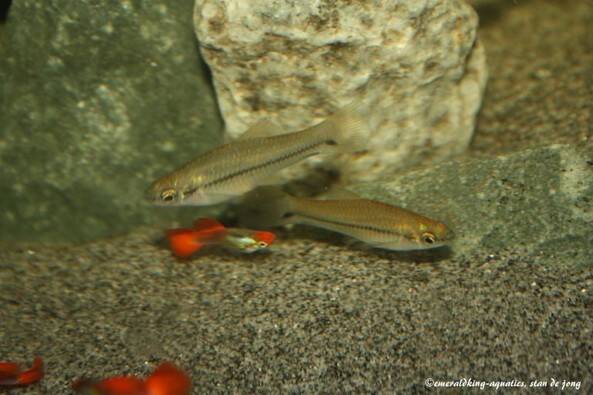
A unique feature of this swordtail species is that all attempts to crossbreed this species to another swordtail species failed thusfar. The conclusion is that this swordtail species won't interbreed with other swordtail (and assumable also not with platies) species. This makes the comma swordtail a good tankmate with another swordtail species without the risk of hybrids.
In 1979, Rosen studied both phylogenetic ( phylogenetics = is a part of systematics that addresses the inference if the evolutionary history and relationships among or within groups of organisms (e.g., species) relationships and interbreeding potential of four breeding species of Xiphophorus. These species and their interrelationships are shown in the figure below (X. sp. is an undescribed species). Xiphophorus signum is the most derived species of the group and is reproductively isolated from X.hellerii, as shown by sperm competition experiments (a criterion well established for reproductive isolation among Poeciliids). Xiphophorus signum is also reproductively isolated from X. alvarezi. But X. hellerii and X. alvarezi won't hybridize where they ranges contact in nature with X.signum. We may conclude that X. signum has different and apomorphic (distinguishing an organism or taxon from others that share the same ancestor) features incorporated into its reproduction and development, whereas X. hellerii and X. alvarezi are similar and plesiomorphic (sharing a character state with an ancestral clade) for these features (at least to the point that development is not impaired). Their ability to interbreed is due to the retention of plesiomorphic features, not to the fact that they are closest relatives. One should be aware of the assumption that the ability to interbreed denotes a close phylogenetic relationship, In this case, that criterion would have led to a mistake in analysis.

This brings up the interesting point that the significance of both hybridization and introgression depends on the phylogenetic position of the species.The ability to breed succesfully is, potentially, a primitive character. Within the history of any lineage, reproductive compatibility is an attribute of the members of the ancestral species of that lineage; an attribute which is gradually diminished and ultimately lost in its descendants during geographic differentiation. Reproductive compatibility is not necessarily evidence of close relationship.
Like some other swordtail species, the male characteristics will show up very late. Even females show a gravid spot for the first time pretty late. Therefore, only with almost full sized 7 cm (max. 10 cm without the length of a sword) specimens, it wil become clear what kind of gender they are.


Above: A male which starts developing a sword (photo right).
This southern swordtail resemble more the northern swordtail. Scientist believe that the comma swordtail is a primitive form of the swordtail fish in general which developed itself in an isolated area till a certain degree unlike other wild swordtail species that have a wider range where they occur. And therefore they'll have more phenotypes than the comma swordtail.
These comma swordtail do fine at temperatures between 17 - 26°C. And it's also better for their health if we fluctuate the temperature on a regular basis. So, also this swordtail makes a good contender to keep outdoors during the better months of the year.
Río Chajmaic Cajbón is a stream in Alta Verapaz Department, Guatemala. Río Chajmaic Cajbón is situated nearby to the locality El Azufre, as well as near La Caoba.

The Rio Semococh is a short river that originates southeast of the town of the Chajmaic farm, between the municipality of Cahabón, Department of Alta Verapaz, Guatemala. Coordinates: 15°43'60" N, 89°57'0" W.

Xiphophorus kallmani
The Catemaco swordtail (Xiphophorus kallmani) also known as "Brass swordtail" occurs in lake Catemaco, Papaloapan drainage, Veracruz in Mexico. Don't mistake Catemaco swordtail with Catemaco platy (Xiphophorus milleri).
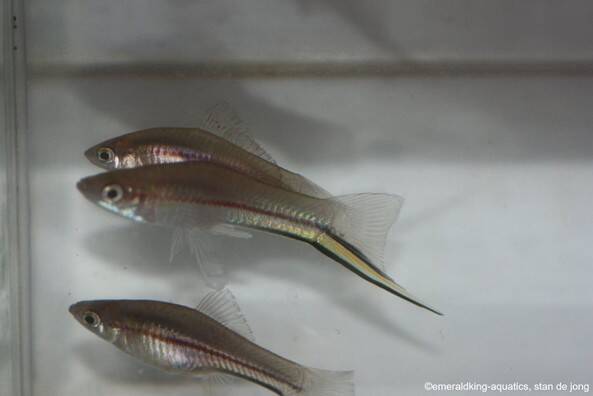
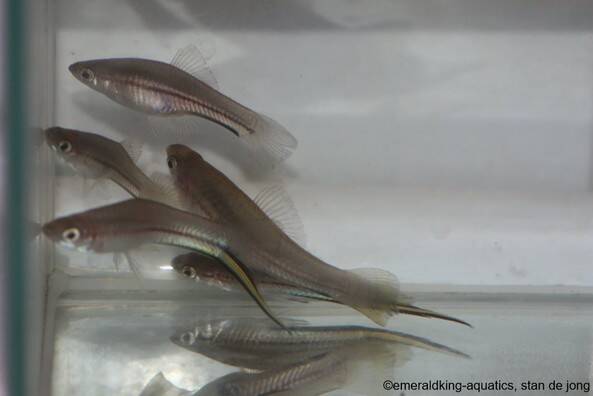
This swordtail does have a beautiful metallic golden shine on its body. There's not that much information about this species but it's been described by Manfred Schartl and Meyer (2003).
This species can reach up to 10 - 12 cm of length. They're quite hardy and do tolerate temperatures between 18 - 28°C.

Below: Lake Catemaco (Lago de Catemaco).


Fancy swordtails
I'd like to reply on the frequent shown question at forums, which is: Are all fancy swordtails the result of a crossbreeding between swordtail and platy? The answer is: No! I do understand why people think that. For there are so many fancy platy strains that have the same coloration and/or pattern as many fancy swordtail strains. Most of them are a crossbreeding between platy and swordtail. But there are also fancy strains (specifically in the early years of fancy swordtails) that only have swordtail blood in them.
Just like other livebearer species it started with natural mutations that were kept separate and linebred with those specific traits that occurred by mutation. But also the color red that many fancy swordtails carry. Yes, there have been cross breedings between platy and swordtail to pass on the red color. But in free nature red specimens do occur. But be aware that such a red coloration has got a specific meaning with certain kinds of wild green swordtails. It marks down the pecking order within a group. For instance, this phenomenon occurs with a number of males of the Yucatan and Alvarezi swordtails. They're born as green specimens and will turn partially till total red as an adult. And it starts from the lower part of the body upwards. The degree of red coloration will impact the dominance of the male.
But if you linebreed the most red green males, the red becomes more present in the phenotype. At some point, you'll be able to develop just red swordtails as well. There are even females that will show red on their green body.
So, assuming that all fancy swordtails are "only" the result of a cross breeding between swordtail and platy would be an incorrect thought.
A remark about the scientific name of most breeding forms of swordtails. Commerciallywise, they're all labeled as being "Xiphophorus hellerii. But when we're dealing with a breeding form that is a result of Hellerii swordtail x maculatus platy or Helllerii swordtal x Variatus platy, we can't actually label them as being "Xiphophorus hellerii" anymore. Probably best to label them as "Xiphophorus swordtail cf.". But in general, we don't give scientifc names to hybrids.
Xiphophorus hellerii pearl white
Besides wild strains, I also do keep and breed fancy strains. One of them is the white swordtail. Although white swordtail strains already exsist, it's a bit hard to get your hands on some where I'm located. So, I've decided to create my own whites.

I've used blue swordtails with koi (kohaku) swordtails back in 2015. It took a while before I had real whites. The male above and below does show some orange in its gonopodium (a left over from the koi swordtails).
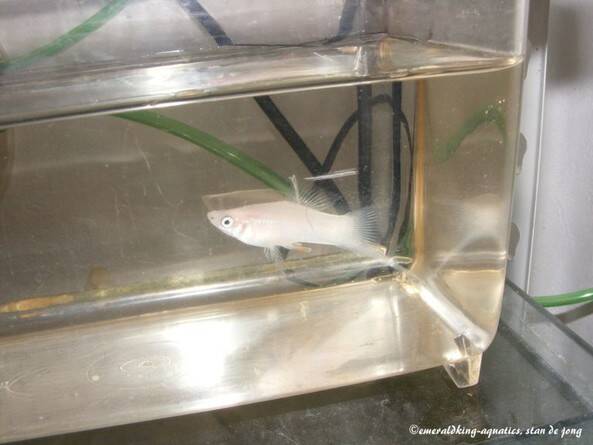
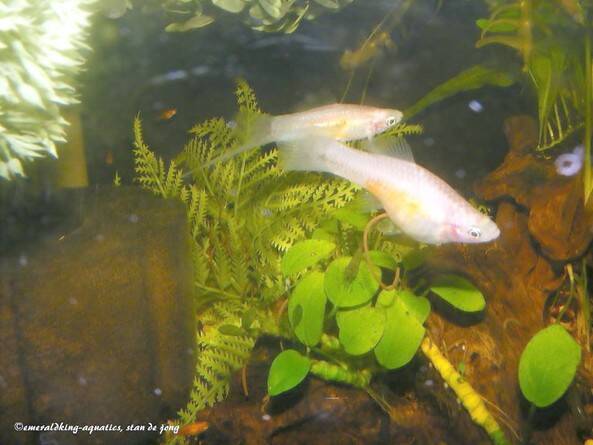
Above: An adult male (photo left) and an adult couple (photo right) which shows already a lot more white (January 2016).
I've started culling those most white offspring to accomplish my goal.

Above: complete white and red swordtail fry.
Below: A picture of a male (January 2016) with still some blue and some orange. But most of those markings has disappeared till the final whites occurred. And two juvenile white swords (photo right).
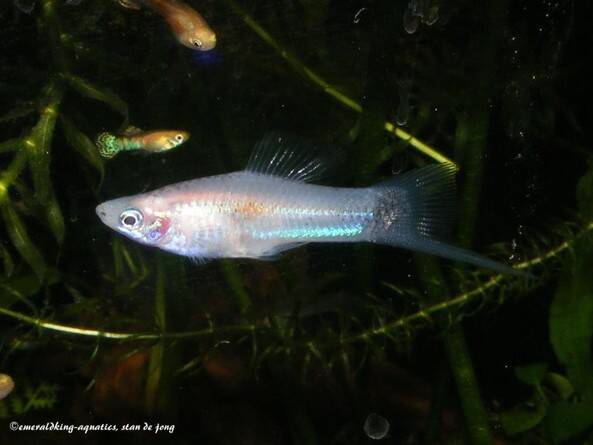
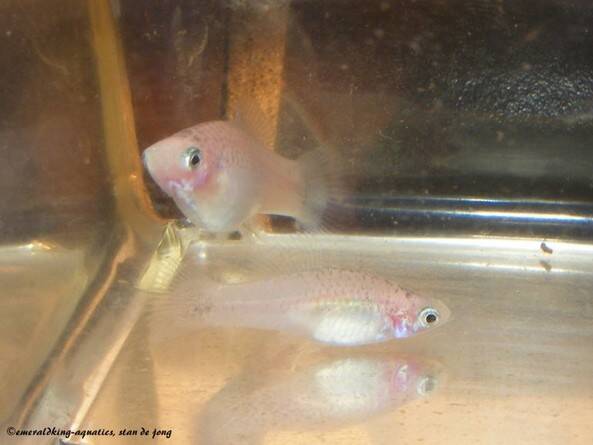
Below: An albino white swordtail male.

Xiphophorus hellerii red velvet
I do love red swordtails, despite of the fact that they're fancy swordtails. But the red velvet version is the one I love most. This red is dark red. And yes, the skin looks like velvet.

These swordtails do grow up large and they've got a ferm body build. I do have to say that dominance among both males and females do occur very often with this kind.


Above: Two pictures of clearly well built red velvet swordtails.
They need a lot of space to develop a good body size. They're also very prolific and batches of 50-80 fry seems normal. and what's also remarkable is that they won't eat their fry. At least, by my own experience these adults will leave their offspring alo

Above: an adult male with a good shaped body. It does show a healthy appearance. This one reached 13 cm (sword included). But several sizes will occur in each strain. But this is also a large male. But in the wild a number of wild species can even grow larger.
Xiphophorus hellerii Cauliflower
This hi-fin swordtail seems to be a Chinese cross just like his cousin the "Sabertail". The difference between the standard cauliflower and the sabertail is that the sabertail has got a saber shaped sword. The name "cauliflower" itself refers to the shape of the elongated dorsal of both genders. But the female has got a less elongated dorsal in comparison to the male.
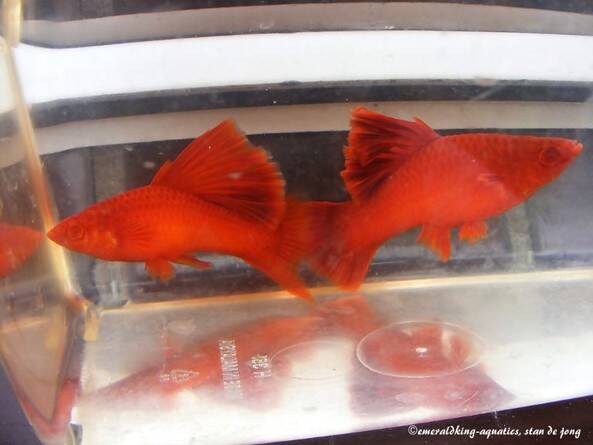

It's got a sturdy build body shape, which is quite unique for a swordtail fish. In my opinion the body shape reminds me of a mix of swordtail and molly.
They're red eyed which would make them suitable for a tank with dimmed light. Most albinos and lutinos are sensitive to bright light.
Among fancy swordtails, this sports is a majestic one. Its whole appearance shows class, strength and respect.

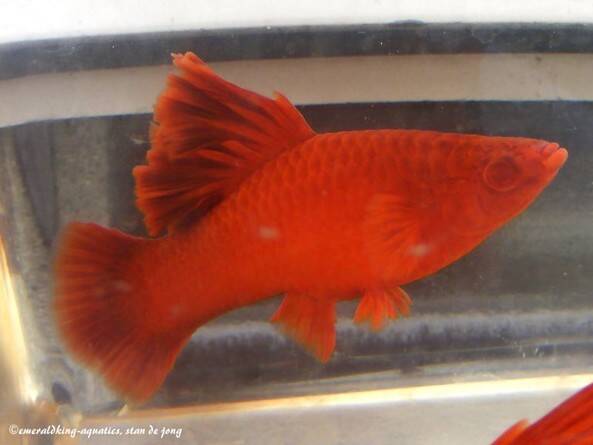
Above: An adult male (photo left) and an adult female (photo right).
Just like the cauliflower swordtail, there are multiple fancy swordtail strains with a high or large dorsal. This so-called Hifin (or Hi-Fin) swordtail was firstly developed in the beginning of the 1960's. Thelma Hobson Simpson was a pionier within this field. These Hifins were called Simpson swordtails, named after Thelma Hobson Simpson.
This trait has also been integrated in strains of Xiphophorus maculatus and Xiphophorus variatus.



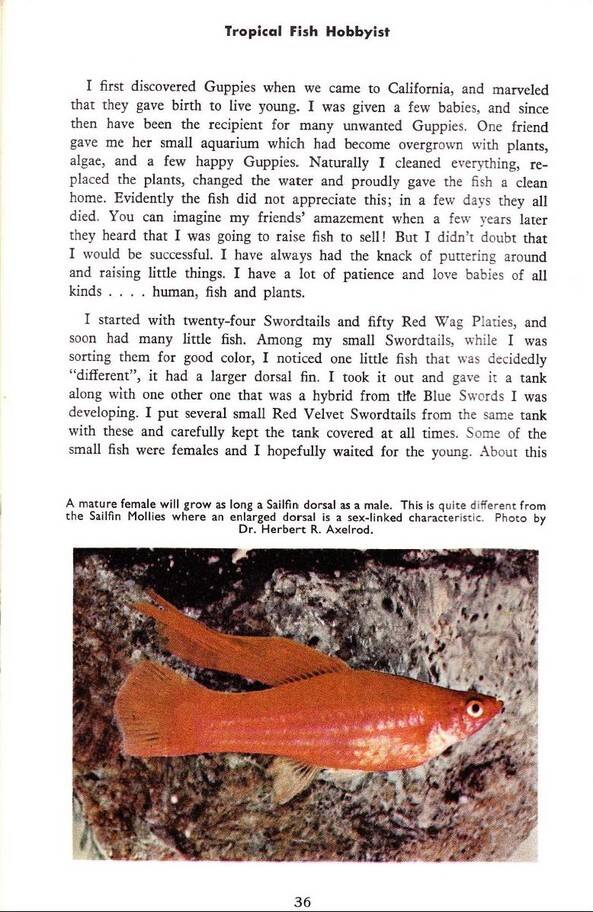
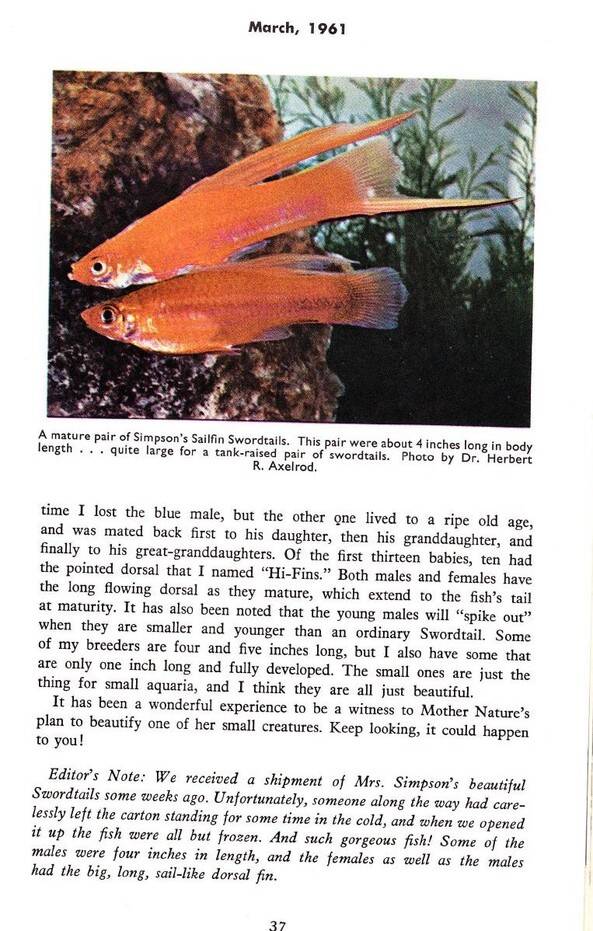
Although the Hifin gene is dominant, a fish can't be homozygous for Hifin (HH), as two doses of the gene are lethal. In order to produce Hifins, one would need to cross a Hifin (Hh) to another Hifin (Hh), yielding 66% Hifins, or a Hifin (Hh) to a normal fin (hh) yielding 50% Hifins. This implies a true-breeding hifin strain is almost impossible. I'm saying deliberately "almost", for there are statements that refer to almost a full batch of Hifins.
Overhere a number of Hifins:
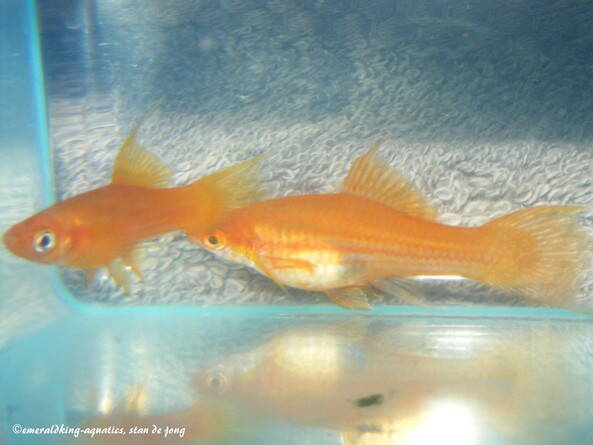
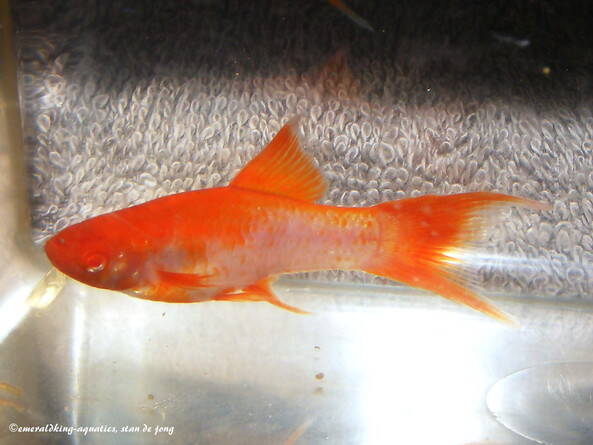
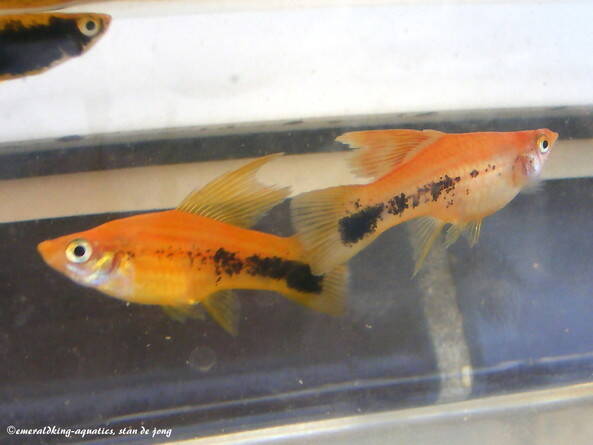
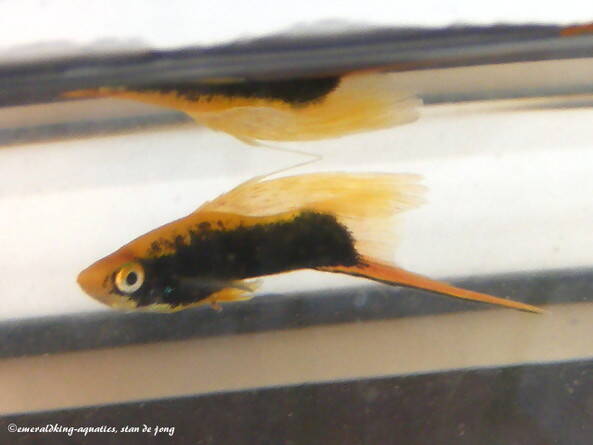
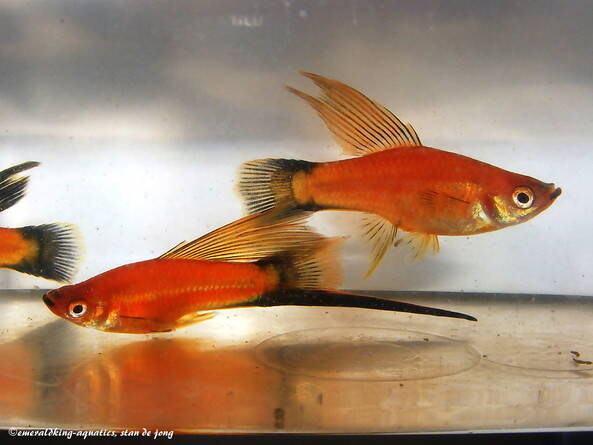

Below: Some odd colored fancy swordtails...


